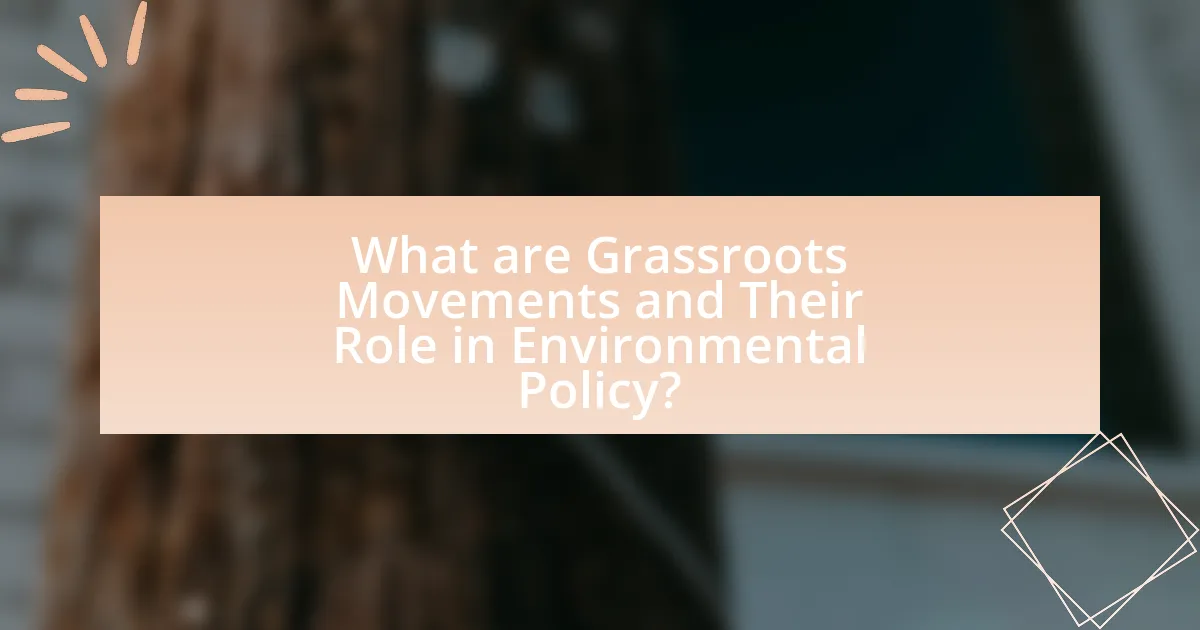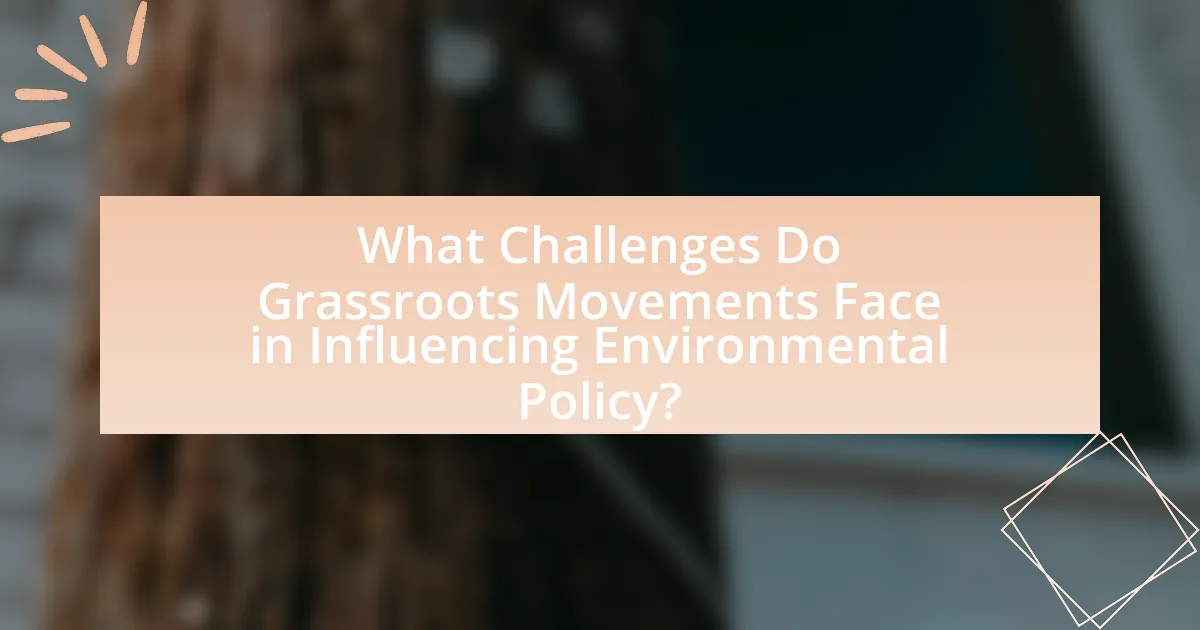Grassroots movements are organized efforts by individuals at the community level aimed at advocating for environmental change and influencing policy. This article examines the significant role these movements play in shaping environmental policy through community engagement, public awareness, and advocacy strategies. It highlights historical examples, such as the establishment of Earth Day and the 2019 climate strikes, illustrating how grassroots activism can lead to tangible policy changes. Additionally, the article discusses the challenges faced by grassroots movements, including limited resources and political resistance, while emphasizing best practices for enhancing their impact on environmental advocacy.

What are Grassroots Movements and Their Role in Environmental Policy?
Grassroots movements are organized efforts by ordinary people at the community level to advocate for environmental change and influence policy. These movements play a crucial role in shaping environmental policy by raising awareness, mobilizing public support, and pressuring decision-makers to adopt sustainable practices. For instance, the 2019 global climate strikes, initiated by youth activists, successfully brought climate change to the forefront of political discourse, leading to increased commitments from governments worldwide to reduce carbon emissions. Such movements demonstrate the power of collective action in driving policy changes that prioritize environmental protection and sustainability.
How do grassroots movements influence environmental policy decisions?
Grassroots movements influence environmental policy decisions by mobilizing public support, raising awareness, and advocating for specific changes. These movements often engage communities directly, fostering a sense of urgency around environmental issues, which can lead to increased political pressure on policymakers. For example, the 2014 People’s Climate March, which drew over 400,000 participants in New York City, significantly raised awareness about climate change and pressured local and national leaders to take action. Additionally, grassroots organizations frequently utilize social media to amplify their messages, reaching wider audiences and influencing public opinion, which can sway legislative agendas. Studies have shown that grassroots activism can lead to tangible policy changes, such as the adoption of renewable energy initiatives and stricter environmental regulations, demonstrating their effectiveness in shaping environmental policy.
What strategies do grassroots movements employ to effect change?
Grassroots movements employ strategies such as community organizing, advocacy, coalition building, and public awareness campaigns to effect change. Community organizing involves mobilizing local individuals to address specific issues, fostering a sense of ownership and empowerment among participants. Advocacy efforts focus on influencing policymakers through lobbying and direct engagement, often supported by research and data to strengthen their positions. Coalition building brings together diverse groups to amplify their collective voice, enhancing their impact on environmental policies. Public awareness campaigns utilize social media, events, and educational initiatives to inform and engage the broader public, driving support for their causes. These strategies have been effective in various historical contexts, such as the successful mobilization of grassroots efforts during the 2016 Standing Rock protests against the Dakota Access Pipeline, which highlighted the power of community action in influencing environmental policy.
How do grassroots movements mobilize community support for environmental issues?
Grassroots movements mobilize community support for environmental issues by fostering local engagement and raising awareness through direct action and education. These movements often utilize community organizing strategies, such as town hall meetings, workshops, and social media campaigns, to inform residents about environmental challenges and solutions. For instance, the Sierra Club’s grassroots campaigns have successfully mobilized thousands of volunteers to advocate for clean energy policies, demonstrating the effectiveness of localized efforts in influencing broader environmental policy. Additionally, studies show that communities involved in grassroots initiatives are more likely to participate in environmental advocacy, as seen in the 2019 report by the Environmental Protection Agency, which highlighted increased community involvement in sustainability practices linked to grassroots efforts.
Why are grassroots movements important in the context of environmental policy?
Grassroots movements are important in the context of environmental policy because they mobilize community engagement and influence decision-making at local, national, and global levels. These movements often raise awareness about environmental issues, advocate for sustainable practices, and hold policymakers accountable. For instance, the 2019 climate strikes led by youth activists significantly impacted public discourse and prompted governments to prioritize climate action, demonstrating the power of grassroots advocacy in shaping environmental policy.
What historical examples illustrate the impact of grassroots movements on environmental legislation?
Grassroots movements have significantly influenced environmental legislation, with notable examples including the establishment of Earth Day in 1970 and the anti-nuclear movement in the 1970s. Earth Day mobilized millions of Americans to advocate for environmental protection, leading to the creation of the Environmental Protection Agency and the passage of key legislation such as the Clean Air Act and the Clean Water Act. The anti-nuclear movement, driven by grassroots activism against nuclear power plants, resulted in stricter regulations and a shift in public policy towards renewable energy sources. These movements demonstrate how collective action can effectively shape environmental policy and legislation.
How do grassroots movements challenge traditional power structures in environmental governance?
Grassroots movements challenge traditional power structures in environmental governance by mobilizing local communities to advocate for sustainable practices and policies that often contradict the interests of established authorities and corporations. These movements leverage collective action, social media, and public demonstrations to raise awareness about environmental issues, thereby pressuring governments and institutions to adopt more inclusive and environmentally friendly policies. For instance, the Standing Rock Sioux Tribe’s opposition to the Dakota Access Pipeline galvanized national attention and highlighted the importance of indigenous rights in environmental decision-making, demonstrating how grassroots activism can disrupt conventional governance frameworks.

What are the Key Characteristics of Successful Grassroots Movements?
Successful grassroots movements are characterized by strong community engagement, clear goals, effective communication, and adaptability. Community engagement fosters a sense of ownership and mobilizes individuals to participate actively, as seen in the 2019 climate strikes led by youth activists, which drew millions globally. Clear goals provide direction and purpose, exemplified by the Zero Waste movement, which aims to reduce landfill waste through specific targets. Effective communication, often facilitated by social media, allows for rapid information dissemination and mobilization, as demonstrated by the #MeToo movement, which gained traction through online platforms. Lastly, adaptability enables movements to respond to changing circumstances and challenges, a trait evident in the Black Lives Matter movement, which has evolved its strategies in response to ongoing social issues. These characteristics collectively contribute to the success and impact of grassroots movements on environmental policy and social change.
What factors contribute to the effectiveness of grassroots movements in environmental advocacy?
Grassroots movements in environmental advocacy are effective due to their ability to mobilize community engagement, leverage social media for awareness, and create localized solutions that resonate with specific populations. Community engagement fosters a sense of ownership and responsibility among participants, leading to increased participation and support for environmental initiatives. For instance, the Sierra Club’s grassroots campaigns have successfully mobilized local communities to advocate for policy changes, demonstrating the power of collective action. Additionally, social media platforms enable grassroots movements to reach wider audiences quickly, facilitating the rapid dissemination of information and rallying support for environmental causes. Research shows that campaigns utilizing social media can increase public awareness and participation by up to 50%. Finally, grassroots movements often develop tailored solutions that address local environmental issues, making their advocacy more relevant and impactful. This localized approach has been evident in movements like the Standing Rock protests against the Dakota Access Pipeline, which highlighted specific environmental concerns tied to the community’s land and water resources.
How does community engagement enhance the success of grassroots movements?
Community engagement significantly enhances the success of grassroots movements by fostering a sense of ownership and collective action among participants. When individuals actively participate in their communities, they are more likely to mobilize resources, share information, and advocate for change, which is crucial for the effectiveness of grassroots initiatives. For instance, research by the Stanford Social Innovation Review highlights that grassroots movements with strong community involvement can increase public awareness and support, leading to more substantial policy changes. Additionally, engaged communities often develop networks that facilitate collaboration and amplify their voices, making it easier to influence environmental policy effectively.
What role does social media play in the mobilization of grassroots movements?
Social media serves as a crucial tool for the mobilization of grassroots movements by facilitating rapid communication, organization, and outreach. It enables activists to share information, coordinate events, and engage supporters in real-time, significantly amplifying their reach and impact. For instance, the #FridaysForFuture movement, initiated by Greta Thunberg, utilized platforms like Twitter and Instagram to mobilize millions globally for climate action, demonstrating how social media can effectively galvanize public support and participation in grassroots initiatives.
How do grassroots movements build coalitions with other organizations?
Grassroots movements build coalitions with other organizations by identifying shared goals and values, which fosters collaboration. These movements often engage in outreach to like-minded groups, facilitating discussions that highlight mutual interests, such as environmental protection or social justice. For instance, the Sierra Club has successfully partnered with local community organizations to amplify their advocacy efforts, demonstrating that aligning objectives can enhance collective impact. Additionally, grassroots movements utilize social media and public events to raise awareness and attract diverse stakeholders, further solidifying their coalitions. This strategic approach not only broadens their support base but also strengthens their influence in shaping environmental policy.
What are the benefits of collaboration between grassroots movements and larger environmental organizations?
Collaboration between grassroots movements and larger environmental organizations enhances advocacy effectiveness and resource mobilization. Grassroots movements often possess localized knowledge and community engagement, which can inform larger organizations about specific environmental issues and solutions. For instance, the collaboration during the 2014 People’s Climate March, which involved both grassroots activists and established organizations like Greenpeace, demonstrated how combined efforts can amplify public awareness and influence policy changes. This partnership allows for a broader reach, leveraging the networks and funding of larger organizations while maintaining the grassroots’ authenticity and community ties.
How can grassroots movements leverage partnerships to amplify their impact?
Grassroots movements can leverage partnerships to amplify their impact by collaborating with established organizations, which enhances resource access and visibility. For instance, partnerships with environmental NGOs can provide grassroots movements with funding, expertise, and networks that are crucial for scaling their initiatives. A notable example is the collaboration between local community groups and larger environmental organizations during the 2019 Global Climate Strike, where grassroots efforts were significantly bolstered by the logistical and promotional support of larger entities, resulting in millions of participants worldwide. This synergy not only increases the reach of grassroots messages but also strengthens advocacy efforts, making them more effective in influencing environmental policy.

What Challenges Do Grassroots Movements Face in Influencing Environmental Policy?
Grassroots movements face significant challenges in influencing environmental policy, primarily due to limited resources, lack of political access, and opposition from established interests. Limited financial and human resources hinder grassroots organizations from effectively mobilizing support and conducting extensive campaigns. Additionally, these movements often struggle to gain access to political decision-makers, as established entities typically dominate the policy-making process. For instance, a study by the International Institute for Environment and Development highlights that grassroots groups frequently encounter resistance from powerful corporations and government bodies that prioritize economic growth over environmental concerns. This opposition can undermine the credibility and impact of grassroots initiatives, making it difficult for them to effect meaningful change in environmental policy.
What obstacles do grassroots movements encounter in their advocacy efforts?
Grassroots movements encounter several obstacles in their advocacy efforts, including limited funding, lack of media coverage, and resistance from established political entities. Limited funding restricts their ability to organize events, conduct research, and mobilize supporters effectively. For instance, a study by the National Committee for Responsive Philanthropy found that grassroots organizations receive only a small fraction of total philanthropic funding, which hampers their outreach and impact. Lack of media coverage often leads to insufficient public awareness of their causes, making it difficult to gain traction. Additionally, established political entities may resist grassroots initiatives due to perceived threats to their power or interests, as seen in various environmental policy debates where corporate lobbying often overshadows grassroots advocacy. These factors collectively hinder the effectiveness of grassroots movements in influencing environmental policy.
How do funding limitations affect the sustainability of grassroots movements?
Funding limitations critically undermine the sustainability of grassroots movements by restricting their operational capacity and outreach. Without adequate financial resources, these movements struggle to maintain consistent advocacy efforts, organize events, and mobilize community support. For instance, a study by the National Committee for Responsive Philanthropy found that grassroots organizations often receive less than 10% of total philanthropic funding, which directly impacts their ability to influence policy effectively. Consequently, limited funding can lead to reduced visibility and diminished impact, ultimately threatening the longevity and effectiveness of grassroots initiatives in shaping environmental policy.
What strategies can grassroots movements use to overcome political resistance?
Grassroots movements can overcome political resistance by employing strategies such as coalition-building, effective communication, and leveraging social media. Coalition-building allows grassroots organizations to unite diverse groups, increasing their collective power and influence, as seen in the 2014 People’s Climate March, which mobilized over 400,000 participants and amplified demands for climate action. Effective communication involves framing issues in relatable terms to resonate with broader audiences, which has been shown to enhance public support for environmental policies. Additionally, leveraging social media enables grassroots movements to disseminate information rapidly, mobilize supporters, and create viral campaigns, exemplified by the #FridaysForFuture movement initiated by Greta Thunberg, which has inspired global youth activism. These strategies collectively enhance the visibility and impact of grassroots movements, enabling them to navigate and mitigate political resistance effectively.
How do grassroots movements navigate the complexities of environmental policy?
Grassroots movements navigate the complexities of environmental policy by mobilizing community engagement, leveraging local knowledge, and advocating for policy changes through direct action and collaboration. These movements often utilize social media and grassroots organizing to raise awareness about environmental issues, effectively influencing public opinion and policy decisions. For instance, the Standing Rock Sioux Tribe’s opposition to the Dakota Access Pipeline showcased how grassroots activism can challenge large-scale infrastructure projects by highlighting environmental and social justice concerns, ultimately leading to increased scrutiny and policy discussions at various governmental levels.
What role does education and awareness play in overcoming policy challenges?
Education and awareness are crucial in overcoming policy challenges by equipping individuals and communities with the knowledge needed to advocate for effective environmental policies. When people understand the implications of environmental issues, they are more likely to engage in grassroots movements that influence policy decisions. For instance, studies have shown that increased public awareness about climate change leads to greater support for policies aimed at reducing carbon emissions, as evidenced by the rise in public backing for the Paris Agreement following widespread educational campaigns. Furthermore, informed citizens can hold policymakers accountable, ensuring that environmental concerns are prioritized in legislative agendas.
How can grassroots movements adapt to changing political landscapes?
Grassroots movements can adapt to changing political landscapes by employing flexible strategies that respond to shifts in public sentiment and policy priorities. For instance, these movements can utilize social media platforms to quickly mobilize support and disseminate information, as seen in the rise of climate activism where organizations like Fridays for Future have effectively engaged younger audiences. Additionally, grassroots movements can form coalitions with other organizations to amplify their influence, as demonstrated by the collaboration between environmental groups and social justice organizations during the climate strikes. This adaptability is crucial, as political landscapes can shift rapidly due to elections, policy changes, or social movements, necessitating a responsive approach to maintain momentum and achieve policy goals.
What Best Practices Can Grassroots Movements Adopt for Greater Impact?
Grassroots movements can adopt several best practices for greater impact, including building strong community networks, leveraging social media for outreach, and engaging in strategic partnerships. Strong community networks foster trust and collaboration, which are essential for mobilizing support and resources. For instance, the Sierra Club effectively utilized local chapters to engage communities in environmental advocacy, resulting in significant policy changes. Leveraging social media allows grassroots movements to reach wider audiences quickly; campaigns like #FridaysForFuture have demonstrated how digital platforms can amplify messages and mobilize global participation. Additionally, forming strategic partnerships with established organizations can enhance credibility and resource access, as seen in the collaboration between grassroots groups and larger NGOs during climate action initiatives. These practices collectively enhance the effectiveness and reach of grassroots movements in influencing environmental policy.
How can grassroots movements effectively measure their impact on environmental policy?
Grassroots movements can effectively measure their impact on environmental policy by utilizing quantitative and qualitative metrics, such as policy changes, public engagement levels, and environmental outcomes. For instance, tracking specific legislation influenced by grassroots campaigns, such as the adoption of renewable energy standards or pollution reduction targets, provides concrete evidence of policy impact. Additionally, surveys and public opinion polls can gauge shifts in community awareness and support for environmental issues, reflecting the movement’s influence. Research by the Stanford Social Innovation Review highlights that successful grassroots movements often document their activities and outcomes, allowing for a clear assessment of their effectiveness in shaping policy.
What are the key lessons learned from successful grassroots movements in environmental advocacy?
Successful grassroots movements in environmental advocacy demonstrate the importance of community engagement, strategic messaging, and coalition-building. Community engagement fosters local ownership and mobilizes individuals to take action, as seen in the 2014 People’s Climate March, which drew over 400,000 participants in New York City, highlighting the power of collective action. Strategic messaging ensures that the movement resonates with diverse audiences, effectively communicating the urgency of environmental issues, as evidenced by the success of the “Fridays for Future” movement initiated by Greta Thunberg, which utilized social media to amplify its message globally. Coalition-building among various stakeholders, including NGOs, local governments, and businesses, enhances credibility and resources, exemplified by the collaboration in the 2016 Standing Rock protests against the Dakota Access Pipeline, which united Indigenous groups and environmental activists. These lessons underscore the effectiveness of grassroots movements in shaping environmental policy through active participation, clear communication, and collaborative efforts.